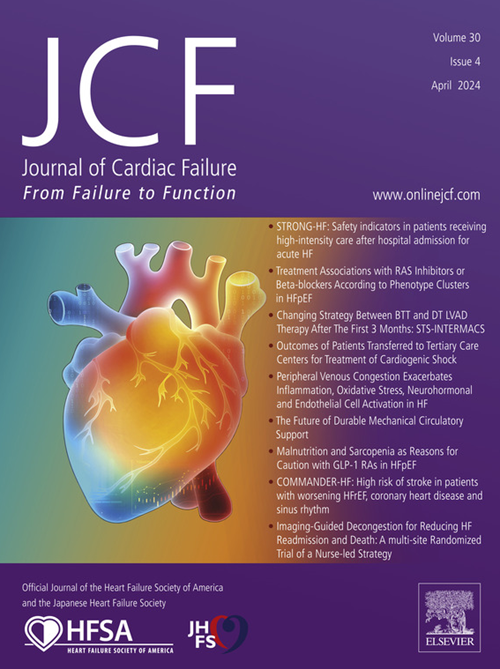用于心衰死亡率风险分层的冠状动脉钙:冠状动脉钙联盟。
IF 8.2
2区 医学
Q1 CARDIAC & CARDIOVASCULAR SYSTEMS
引用次数: 0
摘要
背景:心力衰竭(HF)是导致发病和死亡的主要原因之一,同时也造成了沉重的经济负担,因此人们对心力衰竭的预测越来越感兴趣。冠状动脉钙化(CAC)是一种简便廉价的检测方法,但它在预测无症状成年人长期高血压死亡率方面的作用仍不清楚。我们旨在确定 CAC 联合会中的 CAC 负荷是否与高血压相关死亡率有关:研究纳入了来自 CAC 联合会的 66,636 名一级预防患者。采用多变量竞争风险回归评估 CAC 与心房颤动相关死亡率之间的关系,并对人口统计学和传统风险因素进行调整。平均年龄为 54.4 岁,67% 为男性,89% 为白人,55% 的 CAC >0。在 12.5 年的中位随访期间,共观察到 260 例心房颤动相关死亡事件,其中 75.3% 发生在基线 CAC 评分 >100 的患者中。与 CAC = 0 相比,CAC 为 1-100 分(亚分布危险比 [SHR]:2.27;95% CI:1.3-3.99)、100-400 分(SHR:3.68;95% CI:2.1-6.43)和大于 400 分(SHR:7.05;95% CI:4.05-12.29)的患者发生心房颤动相关死亡的风险呈递增趋势(P < 0.005)。根据汇总队列(PCE)和PREVENT方程计算,CAC评分越高,心房颤动死亡风险越高,这种情况在不同年龄组、性别以及中高风险组中持续存在:在一级预防人群中,CAC越高,心房颤动相关的长期死亡率越高,尤其是中危和高危患者。高 CAC 患者的早期预防方法必须侧重于通过改变生活方式和药物来预防心衰和 ASCVD。本文章由计算机程序翻译,如有差异,请以英文原文为准。
Coronary Artery Calcium for Risk Stratification of Heart Failure Mortality: The Coronary Artery Calcium Consortium
Background
There is increasing interest in predicting heart failure (HF), a major cause of morbidity and mortality with a significant financial burden. The role of coronary artery calcium (CAC), an accessible and inexpensive test, in predicting long-term HF mortality among asymptomatic adults remains unknown. We aimed to determine whether CAC burden is associated with HF-related mortality in the CAC Consortium.
Methods and Results
The study included 66,636 primary prevention patients from the CAC Consortium. Multivariable competing risks regression was used to assess the association between CAC and HF-related mortality adjusting for demographics and traditional risk factors. The mean age was 54.4 years, 67% male, 89% White, and 55% had a CAC of >0. We observed 260 HF-related mortality events during a median follow up of 12.5 years; 75.3% occurred among those with a baseline CAC score of >100. Compared with a CAC of 0, there was a stepwise higher risk (P < .005) of HF mortality for a CAC of 1–100 (subdistribution hazard ratio [SHR] 2.27, 95% CI 1.3–3.99), 100–400 (SHR 3.68, 95% CI 2.1–6.43), and >400 (SHR 7.05, 95% CI 4.05–12.29). This increasing risk of HF mortality across higher CAC scores persisted across age groups, sex, and in the intermediate and high-risk groups as calculated by the pooled cohort equation and Predicting Risk of cardiovascular disease EVENTs (PREVENT) equation.
Conclusions
A higher CAC is associated with an increasing incidence of long-term HF-related mortality in the primary prevention population, particularly intermediate and high-risk patients. Early preventive approaches in patients with high CAC must focus on preventing HF and atherosclerotic cardiovascular disease with lifestyle changes and medications.
求助全文
通过发布文献求助,成功后即可免费获取论文全文。
去求助
来源期刊

Journal of Cardiac Failure
医学-心血管系统
CiteScore
7.80
自引率
8.30%
发文量
653
审稿时长
21 days
期刊介绍:
Journal of Cardiac Failure publishes original, peer-reviewed communications of scientific excellence and review articles on clinical research, basic human studies, animal studies, and bench research with potential clinical applications to heart failure - pathogenesis, etiology, epidemiology, pathophysiological mechanisms, assessment, prevention, and treatment.
 求助内容:
求助内容: 应助结果提醒方式:
应助结果提醒方式:


